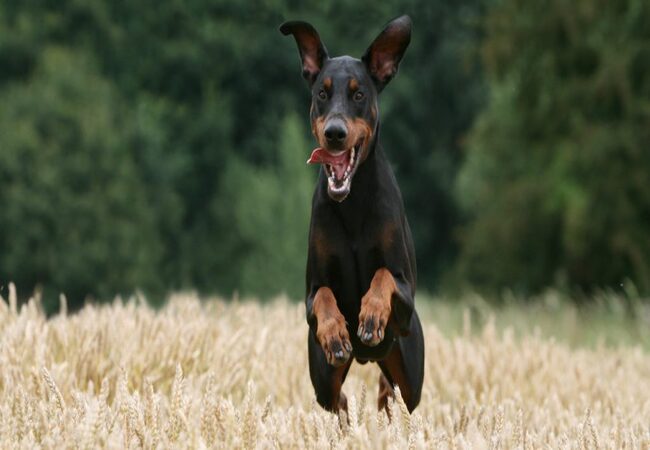Vet’s 2025 Guide to Dancing Doberman Disease (Distal Neuromyopathy)🩺

In this article
Vet’s 2025 Guide to Dancing Doberman Disease (Distal Neuromyopathy)🩺
By Dr. Duncan Houston BVSc
💡 What Is Dancing Doberman Disease?
Dancing Doberman disease, also called distal neuromyopathy or reflex myoclonus, is a rare, likely autosomal recessive genetic condition that affects Doberman Pinschers. It causes involuntary spasms and flexion of the rear legs—often described as “dancing”—that begin in one limb and frequently progress to both. Though dramatic, it typically causes no pain.
🚩 Who Is Affected & Why?
- 🐕 Exclusively seen in Doberman Pinschers; all sexes affected.
- 📅 Onset ranges from 4 months to ~7 years, with early signs common at 6 months.
- 🧬 Genetics appears responsible (autosomal recessive), but no definitive gene identified.
👀 Clinical Signs
- 🦵 Sudden flexion/spasm of one hind leg while standing; dog often shifts weight or appears to “dance.”
- ↔️ Over time, spasms affect both rear legs, making standing uncomfortable; dog may prefer sitting.
- 🧘♂️ Walking and running remain normal; symptoms are posture‑specific.
- 🦴 Progressive muscle atrophy and weakness may develop; rear‑paw knuckling is common.
- ❤️ Dogs show no signs of pain, but may exhibit tingling or discomfort (restless‑leg sensation?).
🧪 Diagnosis & Ruling Out Other Causes
Since there’s no definitive test, diagnosis relies on:
- Clinical history & typical posture-based spasms in standing dogs.
- Physical exam and gait analysis: normal gait, hind-leg spasms when standing.
- Exclude other disorders: arthritis, hip dysplasia, spinal issues, IVDD, Wobbler, myasthenia gravis, neuromuscular disease—usually via x‑rays, MRI/myelogram.
- Bloodwork: may show elevated muscle enzymes—AST, ALT, CK, LDH—but otherwise normal.
- Electrodiagnostics (EMG): can show spontaneous muscle activity; nerve conduction may be reduced.
- Muscle/nerve biopsy: shows peripheral nerve or muscle changes, but not definitive.
🛠 Treatment & Management
- ⚠️ *No cure or disease‑modifying therapy exists*.
- Supportive therapies:
- 👐 Physical therapy—massage, passive range-of-motion to maintain muscle mass and flexibility.
- 🏊♂️ Hydrotherapy and swimming help maintain strength and reduce atrophy.
- 💡 Laser therapy, acupuncture and thermotherapy may provide comfort—evidence is anecdotal.
- 💊 Consider muscle relaxants or anti‑seizure meds (e.g., phenobarbital, gabapentin) to reduce spasm severity.
- ✅ Quality of life is generally good: dogs run, play, and live normally.
- 🔄 Progressive weakness may require ongoing mobility aids like ramps, paw pads, or assist slings.
- 🧠 Avoid breeding affected dogs due to genetic basis.
📈 Prognosis
- ✅ Life expectancy remains normal; disease progresses slowly over years.
- 📉 Muscle atrophy and rear-leg weakness may worsen with time.
- 🩻 Prognosis is better when other neuromuscular or orthopedic conditions are ruled out.
- ⚖️ No signs of pain—mobility and comfort generally good with supportive care.
🏡 Ask A Vet App: Support Tools at Home 📲🐾
- 📆 Medication & therapy reminders (massage, PT, clinic appointments).
- 📸 Upload photos/video of standing posture and progression.
- 📊 Record motor function, spasm duration, paw knuckling episodes.
- 🔔 Alerts for declines in mobility or severe weakness—prompt vet evaluation.
- 📚 In-app guides: home massage, hydrotherapy, safe ramp use, assistive equipment.
🔑 Key Takeaways🧠✅
- 🎯 Dancing Doberman disease is a genetic distal neuromyopathy seen only in Dobermans.
- ➿ Causes posture‑dependent rear‑leg spasms while standing; walking is unaffected.
- 🔍 Diagnosis involves ruling out other conditions and using EMG/biopsy for supportive evidence.
- 👣 Supportive therapies maintain mobility, muscle tone, and quality of life.
- 📦 Long-term prognosis is usually good, though muscle atrophy gradually increases.
- 📱 Ask A Vet aids owners with monitoring, alerts, and remote vet collaboration.
🩺 Final Thoughts ❤️
In 2025, Dancing Doberman disease remains incurable—but isn’t life‑limiting. With proper diagnosis, compassionate care, and supportive therapy, affected Dobermans continue to enjoy active, happy lives. Owner engagement, guided by tools like Ask A Vet, ensures ongoing monitoring, therapy continuity, and timely veterinary attention—empowering your dog to keep dancing through life 🐾✨.
Visit AskAVet.com and download the Ask A Vet app to log symptoms, upload videos of spasms, schedule therapy reminders, and stay connected with your vet or neurologist anytime. 📲🐶






